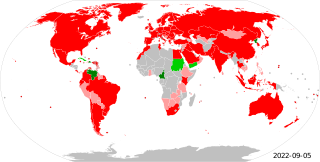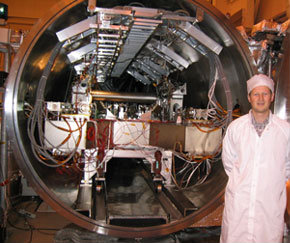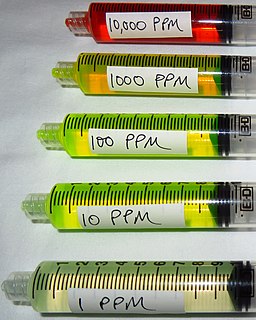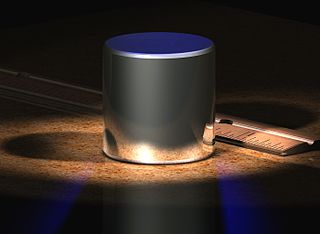A binary prefix is a unit prefix for multiples of units in data processing, data transmission, and digital information, notably the bit and the byte, to indicate multiplication by a power of 2.

The International Bureau of Weights and Measures is an intergovernmental organisation, through which its 59 member-states act together on measurement standards in four areas: chemistry, ionising radiation, physical metrology, and coordinated universal time. It is based in Saint-Cloud, Paris, France. The organisation has been referred to as IBWM in older literature.
The General Conference on Weights and Measures is the supreme authority of the International Bureau of Weights and Measures (BIPM), the intergovernmental organization established in 1875 under the terms of the Metre Convention through which member states act together on matters related to measurement science and measurement standards. The CGPM is made up of delegates of the governments of the member states and observers from the Associates of the CGPM. Under its authority, the International Committee for Weights and Measures executes an exclusive direction and supervision of the BIPM.

The Metre Convention, also known as the Treaty of the Metre, is an international treaty that was signed in Paris on 20 May 1875 by representatives of 17 nations. The treaty created the International Bureau of Weights and Measures (BIPM), an intergovernmental organization under the authority of the General Conference on Weights and Measures (CGPM) and the supervision of the International Committee for Weights and Measures (CIPM), that coordinates international metrology and the development of the metric system.

The International System of Units, known by the international abbreviation SI in all languages and sometimes pleonastically as the SI system, is the modern form:41 of the metric system and based on the metre as the unit of length and either the kilogram as the unit of mass or the kilogram-force as the unit of force.</ref> and the world's most widely used system of measurement.:252 Established and maintained by the General Conference on Weights and Measures (CGPM), it is the only system of measurement with an official status in nearly every country in the world, employed in science, technology, industry, and everyday commerce. The SI comprises a coherent system of units of measurement starting with seven base units, which are the second, metre, kilogram, ampere, kelvin, mole, and candela. The system can accommodate coherent units for an unlimited number of additional quantities. These are called coherent derived units, which can always be represented as products of powers of the base units. Twenty-two coherent derived units have been provided with special names and symbols. The seven base units and the 22 coherent derived units with special names and symbols may be used in combination to express other coherent derived units. Since the sizes of coherent units will be convenient for only some applications and not for others, the SI provides twenty prefixes which, when added to the name and symbol of a coherent unit produce twenty additional (non-coherent) SI units for the same quantity; these non-coherent units are always decimal multiples and sub-multiples of the coherent unit. The SI is intended to be an evolving system; units and prefixes are created and unit definitions are modified through international agreement as the technology of measurement progresses and the precision of measurements improves.
A metric prefix is a unit prefix that precedes a basic unit of measure to indicate a multiple or submultiple of the unit. All metric prefixes used today are decadic. Each prefix has a unique symbol that is prepended to any unit symbol. The prefix kilo-, for example, may be added to gram to indicate multiplication by one thousand: one kilogram is equal to one thousand grams. The prefix milli-, likewise, may be added to metre to indicate division by one thousand; one millimetre is equal to one thousandth of a metre.
The dalton or unified atomic mass unit is a unit of mass widely used in physics and chemistry. It is defined as 1⁄12 of the mass of an unbound neutral atom of carbon-12 in its nuclear and electronic ground state and at rest. The atomic mass constant, denoted mu is defined identically, giving mu = m(12C)/12 = 1 Da. A unit dalton is also approximately numerically equal to the molar mass of the same expressed in grams per mole. Prior to the 2019 redefinition of the SI base units these were numerically identical by definition and are still treated as such for most purposes.

Metrology is the scientific study of measurement. It establishes a common understanding of units, crucial in linking human activities. Modern metrology has its roots in the French Revolution's political motivation to standardise units in France, when a length standard taken from a natural source was proposed. This led to the creation of the decimal-based metric system in 1795, establishing a set of standards for other types of measurements. Several other countries adopted the metric system between 1795 and 1875; to ensure conformity between the countries, the Bureau International des Poids et Mesures (BIPM) was established by the Metre Convention. This has evolved into the International System of Units (SI) as a result of a resolution at the 11th General Conference on Weights and Measures (CGPM) in 1960.

The pascal is the SI derived unit of pressure used to quantify internal pressure, stress, Young's modulus, and ultimate tensile strength. The unit, named after Blaise Pascal, is defined as one newton per square metre and is equivalent to 10 barye (Ba) in the CGS system. The unit of measurement called standard atmosphere (atm) is defined as 101,325 Pa.

In science and engineering, the parts-per notation is a set of pseudo-units to describe small values of miscellaneous dimensionless quantities, e.g. mole fraction or mass fraction. Since these fractions are quantity-per-quantity measures, they are pure numbers with no associated units of measurement. Commonly used are parts-per-million, parts-per-billion, parts-per-trillion and parts-per-quadrillion. This notation is not part of the International System of Units (SI) system and its meaning is ambiguous.
Articles related to standards include:
ISO 31 is a superseded international standard concerning physical quantities, units of measurement, their interrrelationships and their presentation. It was revised and replaced by ISO/IEC 80000.
ISO 31-0 is the introductory part of international standard ISO 31 on quantities and units. It provides guidelines for using physical quantities, quantity and unit symbols, and coherent unit systems, especially the SI. It is intended for use in all fields of science and technology and is augmented by more specialized conventions defined in other parts of the ISO 31 standard. ISO 31-0 was withdrawn on 17 November 2009. It is superseded by ISO 80000-1. Other parts of ISO 31 have also been withdrawn and replaced by parts of ISO 80000.
IEEE 1541-2002 is a standard issued in 2002 by the Institute of Electrical and Electronics Engineers (IEEE) concerning the use of prefixes for binary multiples of units of measurement related to digital electronics and computing.
ISO 31-11:1992 was the part of international standard ISO 31 that defines mathematical signs and symbols for use in physical sciences and technology. It was superseded in 2009 by ISO 80000-2:2009 and subsequently revised in 2019 as ISO-80000-2:2019.
ISO 80000 or IEC 80000 is an international standard introducing the International System of Quantities (ISQ). It was developed and promulgated jointly by the International Organization for Standardization (ISO) and the International Electrotechnical Commission (IEC).
The International System of Quantities (ISQ) consists of the quantities used in physics and in modern science in general, starting with basic quantities such as length and mass, and the relationships between those quantities. This system underlies the International System of Units (SI) but doesn't itself determine the units of measurement used for the quantities. It is inherently incomplete.

In metrology, a standard is an object, system, or experiment that bears a defined relationship to a unit of measurement of a physical quantity. Standards are the fundamental reference for a system of weights and measures, against which all other measuring devices are compared. Historical standards for length, volume, and mass were defined by many different authorities, which resulted in confusion and inaccuracy of measurements. Modern measurements are defined in relationship to internationally standardized reference objects, which are used under carefully controlled laboratory conditions to define the units of length, mass, electrical potential, and other physical quantities.

The following outline is provided as an overview of and topical guide to the metric system – various loosely related systems of measurement that trace their origin to the decimal system of measurement introduced in France during the French Revolution.
The Joint Committee for Guides in Metrology (JCGM), is an organization in Sèvres that prepared the "Guide to the expression of uncertainty in measurement" (GUM) and the "International vocabulary of metrology – basic and general concepts and associated terms" (VIM). The JCGM assumed responsibility for these two documents from the ISO Technical Advisory Group 4 (TAG4).







